Hitachi Deskstar 7K1000: Terabyte Storage arrives on the Desktop
by Gary Key on March 19, 2007 8:00 AM EST- Posted in
- Storage
iPeak Business Application Tests
Our iPeak Winstone benchmarks offer a glimpse into how well our hard disk drives will handle general office applications, media encoding, and graphics manipulation. While the business applications that are being tested tend to be more CPU bound at times, the performance of the hard drive can and will make a difference in the more disk intensive video and graphics applications where large media files are typically being edited.
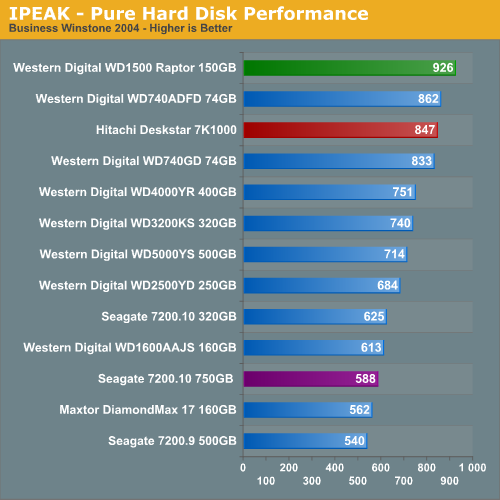
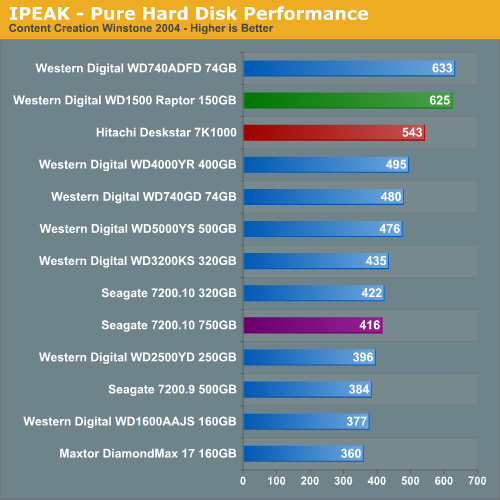
AAs expected the WD Raptor drives finish at the top in our business application tests as their 10k rpm spindle speed and optimized cache play an important role in their ability to sustain high transfer rates, especially in the Content Creation benchmark where transfer block sizes are significantly larger and more random than in the Business application benchmark. We see our 7K1000 performing very well in these tests and finishing ahead of the other 7200rpm drives and even the older 8 MB cache equipped 74GB Raptor.
In fact, the 7K1000 is about 44% faster in the Business Winstone and 30% quicker in the Content Creation benchmarks than the Seagate 750GB drive. After reviewing the trace analysis files we determined that the 7K1000 handles small block sizes of data in non-sequential order significantly better than the Seagate drive. We did notice the drive slowed down slightly in the Business Winstone when it encountered large block sizes of data in non-sequential order. This surprised us slightly as we expected the increase in drive cache to 32 MB would have buffered this same issue we noticed on the Seagate 750GB drive. Overall, the drive offers a very balanced blend of performance across a wide variety of business and home applications.
iPeak General Task Tests
The iPeak based General Task benchmarks are designed to replicate utility based application tasks that typically are disk intensive and represent common programs utilized on the majority of personal computers. While the WinRAR program is very CPU intensive it will typically stress the storage system in short bursts. Our antivirus benchmark will stress the storage system with continual reads and sporadic write requests while the defragmentation process is split between continual read and write requests.
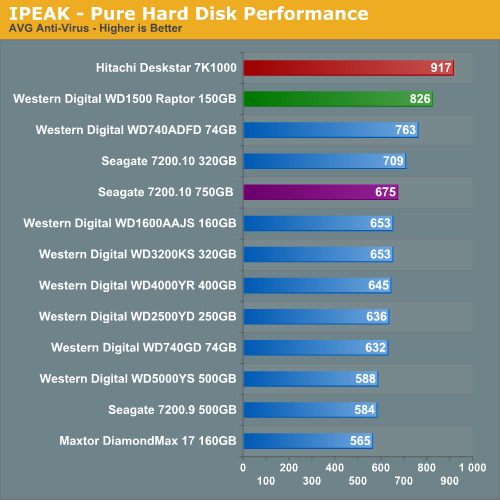
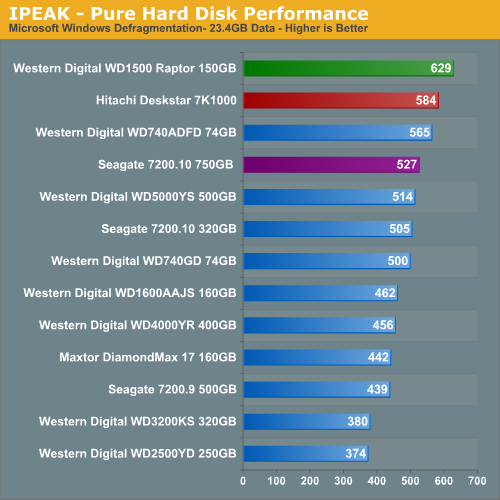
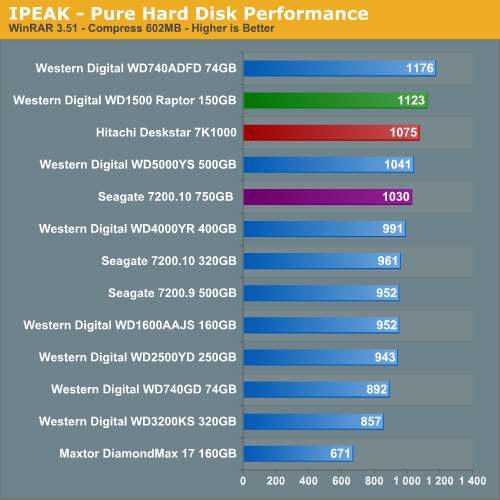
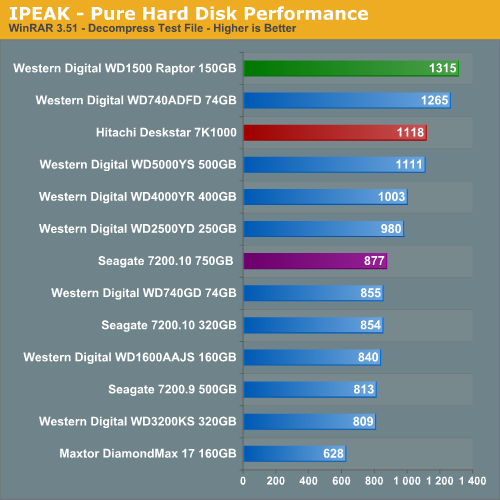
The 7K1000 performs extremely well in the Anti-Virus and Defragmentation test where its 32 MB cache benefits read operations with results that mirror the PCMark 2005 tests. This is especially true in the WinRAR tests where large cache sizes are very advantageous for improved times and we expected better performance from this drive. It did finish ahead of the other 7200rpm drives but simply could not keep up with the rotational and access speeds of the 16 MB cache equipped Raptors.
Our iPeak Winstone benchmarks offer a glimpse into how well our hard disk drives will handle general office applications, media encoding, and graphics manipulation. While the business applications that are being tested tend to be more CPU bound at times, the performance of the hard drive can and will make a difference in the more disk intensive video and graphics applications where large media files are typically being edited.


AAs expected the WD Raptor drives finish at the top in our business application tests as their 10k rpm spindle speed and optimized cache play an important role in their ability to sustain high transfer rates, especially in the Content Creation benchmark where transfer block sizes are significantly larger and more random than in the Business application benchmark. We see our 7K1000 performing very well in these tests and finishing ahead of the other 7200rpm drives and even the older 8 MB cache equipped 74GB Raptor.
In fact, the 7K1000 is about 44% faster in the Business Winstone and 30% quicker in the Content Creation benchmarks than the Seagate 750GB drive. After reviewing the trace analysis files we determined that the 7K1000 handles small block sizes of data in non-sequential order significantly better than the Seagate drive. We did notice the drive slowed down slightly in the Business Winstone when it encountered large block sizes of data in non-sequential order. This surprised us slightly as we expected the increase in drive cache to 32 MB would have buffered this same issue we noticed on the Seagate 750GB drive. Overall, the drive offers a very balanced blend of performance across a wide variety of business and home applications.
iPeak General Task Tests
The iPeak based General Task benchmarks are designed to replicate utility based application tasks that typically are disk intensive and represent common programs utilized on the majority of personal computers. While the WinRAR program is very CPU intensive it will typically stress the storage system in short bursts. Our antivirus benchmark will stress the storage system with continual reads and sporadic write requests while the defragmentation process is split between continual read and write requests.




The 7K1000 performs extremely well in the Anti-Virus and Defragmentation test where its 32 MB cache benefits read operations with results that mirror the PCMark 2005 tests. This is especially true in the WinRAR tests where large cache sizes are very advantageous for improved times and we expected better performance from this drive. It did finish ahead of the other 7200rpm drives but simply could not keep up with the rotational and access speeds of the 16 MB cache equipped Raptors.










74 Comments
View All Comments
phusg - Tuesday, March 20, 2007 - link
I think you are right, but don't forget that in this post you are only looking at it from a performance viewpoint. Drive longevity and acoustics are major factors to me, and I think for you too from the article. I think these are the metrics worth looking at and tend to agree that subjective performance doesn't really differentiate that much (although I haven't had half as much experience with different vendors/models as you have).gramboh - Monday, March 19, 2007 - link
I read the review earlier this morning but don't recall seeing anything about retail channel availability. Did Hitachi or Dell comment to AT about this?I'm actually interested in 500GB 7200.10's and hoping this release will push the price of those down a lot.
Gary Key - Monday, March 19, 2007 - link
We do not have an exact date. Hitachi committed to having product into the retail channel by the end of Q1. We should have an answer from Dell tomorrow on when they will offer it outside of their systems. Hitachi is saying the drive will launch at $399, just waiting to see $550 price tags when the first drives show up... ;)Jeff7181 - Monday, March 19, 2007 - link
This might find it's way into my computer later this year. :)BUL - Monday, March 19, 2007 - link
Interesting that perpendicular technology was chosen given the R&D costs (with the tiny return of ~5 years before obsolescence--the article mentions that perpendicular can ONLY go 5x denser with existing techology & figure we'll see 5TB perpendicular drives in 2 years), etc... So why don't manufacturers offer 5 1/4" drives? Not to invoke memories of the MFM drives of long-ago (the original XT had a double-size 5 1/4" MFM drive of 10MB), but they have potentially 50-60% more surface area per platter, and with a possibility of 7(?) platters, isn't that a better solution? True, you wouldn't put them in SFFs or notebooks, but how many of us have towers with empty 5 1/4" bays??? And I assume that a 1TB 5 1/4" drive would be more energy-efficient than two 500GB 3 1/2" drives...Also, has anyone REALLY tested to see if perpendicular is truly a reliable technology? Seems like manufacturers have 50 years of experience with parallel storage, and only 1-2 years using perpendicular storage...
Spoelie - Tuesday, March 20, 2007 - link
Bulkier, slower, less energy efficient and more moving parts that reduce reliability all in the name of increased capacity is not the way to the future. I think the biggest problem at the moment is NOT storage capacity, they're mostly increasing capacity to keep HDs evolving and not drop in price, as it's one of the only competitive advantages. If you can increase capacity with the same material cost and some extra R&D, it would be stupid not to do it, and a better way than increasing the material cost.In fact, regular folk have way too much capacity at the moment. A Seagate CEO worded it nicely a while back "Face it, we're not changing the world. All we do is enable people to store more crap/porn."
The future lies in the direction of flash based hard drives: smaller, less/no moving parts instead of more, faster access times, lower energy consumption/heat. Or other alternative technologies that offer the same advantages. The densities and cost are the only reasons we're not all buying them at the moment, something that should be fixed over time.
If you're worried about unused case slots, buy one of those things that enable you to install normal hard drives in it, or convince the case designers to include more 3 1/2" slots and less 5 1/4" slots.
misuspita - Monday, March 19, 2007 - link
Have you ever seen a slow motion filming of a cd-rom disk wobbling? Same thing here! I think the platters got smaller because the vibrations produced by them grew with the speed. Since today's r/w heads need to be extremely close to the surface, that would be utterly impossible to control at that speed and diameter. They changed also from an aluminum based disk to an glass based one also, because the roughness of the surface on the Al platter.tygrus - Monday, March 19, 2007 - link
It's harder to spin a large diametter platter at high speed. More weight, more wobble, slower access times. I saw once a 5.25" 4x2.5" SATA drive array. Quantum used to do a large format BigFoot for cheap, slow large capacity but it wasn't continued. We have plenty of capacity per platter but limited perf/GB (worse every year) so why decrease performance to increase capacity ?piroroadkill - Monday, March 19, 2007 - link
All of the Seagate Barracuda 7200.10 drives have been perpendicular for some time..It seems like a perfectly reliable tech to me
Olaf van der Spek - Monday, March 19, 2007 - link
How smart is it to use temperatures from SMART?Did you verify all HDDs use good quality unbiased temperature sensors?
> Our thermal tests utilize sensor readings via the S.M.A.R.T. (Self-Monitoring, Analysis and Reporting Technology) capability of the drives and are reported by utilizing the Active SMART 2.42 utility.